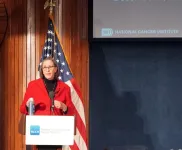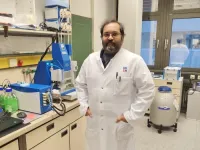(Press-News.org) Amid all the changes in Earth’s climate, sea ice in the stormy Southern Ocean surrounding Antarctica was, for a long time, an odd exception. The maximum winter sea ice cover remained steady or even increased slightly from the late 1970s through 2015, despite rising global temperatures.
That began to change in 2016. Several years of decline led to an all-time record low in 2023, more than five standard deviations below the average from the satellite record. The area of sea ice was 2.2 million square kilometers below the average from the satellite record, a loss almost 12 times the size of Washington state. The most recent winter’s peak, recorded in September 2024, was very close to the previous year’s record low.
University of Washington researchers show that the all-time record low can be explained by warm Southern Ocean conditions and patterns in the winds that circled Antarctica months earlier, allowing forecasts for sea ice coverage around the South Pole to be generated six or more months in advance. This could support regional and global weather and climate models.
The open-access study was published Nov. 20 in Nature Communications Earth & Environment.
“Since 2015, total Antarctic sea ice area has dramatically declined,” said lead author Zac Espinosa, a UW doctoral student in atmospheric and climate science. “State-of-the-art forecasting methods for sea ice generally struggle to produce reliable forecasts at such long leads. We show that winter Antarctic sea ice has significant predictability at six- to nine-month lead times.”
The authors used a global climate model to simulate how ocean and air temperatures, including longer-term cycles like El Niño and La Niña, affect sea ice in the Southern Ocean.
Results showed that the 2023 El Niño was less important than previously thought. Instead, an arching pattern of regional winds, and their effects on ocean temperatures up to six months in advance, could explain 70% of the 2023 record-low winter sea ice. These winds cause ocean mixing in the Southern Ocean that can pull deeper warm water up to the surface, thus suppressing sea ice growth. Winds can also push sea ice poleward toward Antarctica to prevent the sea ice edge from expanding north, transport heat from lower latitudes toward the poles, and generate ocean waves that break up sea ice.
Using the same approach for the 2024 observations correctly predicted that this would be another low year for Southern Ocean sea ice cover.
“It’s interesting that, despite how unusual the winter sea ice conditions were in 2023 and again in 2024, our results show they were remarkably predictable over 6 months in advance,” said co-author Edward Blanchard-Wrigglesworth, a UW research associate professor of atmospheric and climate science.
Antarctic sea ice is important because it affects marine and coastal ecosystems and interactions between ocean and atmosphere in the Southern Ocean. It also affects global climate by reflecting sunlight in the Southern Hemisphere and influencing ice sheets and global currents.
“Antarctic sea ice is a major control on the rate of global warming and the stability of ice on the Antarctic continent,” Espinosa said. “In fact, the sea ice acts to buttress ice shelves, increasing their stability and slowing the rate of global sea level rise. This ice is also important for marine and coastal ecosystems.”
As summer arrives in the Southern Hemisphere, the current sea ice extent remains sparse around Antarctica, close to a record low for this time of the year.
“Our success at predicting these major sea ice loss events so far in advance demonstrates our understanding of the mechanism that caused them,” said co-author Cecilia Bitz, a UW professor of atmospheric and climate science. “Our model and methods are geared up to predict future sea ice loss events.”
The research was funded by the National Science Foundation and the U.S. Department of Energy.
END
Record-low Antarctic sea ice can be explained and forecast months out by patterns in winds
2024-12-06
ELSE PRESS RELEASES FROM THIS DATE:
UTIA team wins grant to advance AI education and career preparation
2024-12-06
Future farmers and leaders in agriculture need to understand and implement technologies that use artificial intelligence. A team of University of Tennessee Institute of Agriculture faculty are working toward creating new curriculum to train the next generation of agriculture students.
Led by Hao Gan, assistant professor in the Department of Biosystems Engineering and Soil Science, the team won a four-year grant for $741,102 from the USDA’s National Institute of Food and Agriculture. The project, “Development of a Smart Agricultural Experiential Learning Program for Youth,” will create hands-on curriculum about using drones, ground robots, computer ...
Magnetically controlled kirigami surfaces move objects: no grasping needed
2024-12-06
Researchers have developed a novel device that couples magnetic fields and kirigami design principles to remotely control the movement of a flexible dimpled surface, allowing it to manipulate objects without actually grasping them – making it useful for lifting and moving items such as fragile objects, gels or liquids. The technology has potential for use in confined spaces, where robotic arms or similar tools aren’t an option.
“We were trying to address two challenges here,” says Jie Yin, co-corresponding ...
Close encounters between distant DNA regions cause bursts of gene activity
2024-12-06
Fukuoka, Japan – Researchers at Kyushu University have revealed how spatial distance between specific regions of DNA is linked to bursts of gene activity. Using advanced cell imaging techniques and computer modeling, the researchers showed that the folding and movement of DNA, as well as the accumulation of certain proteins, changes depending on whether a gene is active or inactive. The study, published on December 6 in Science Advances, sheds insight into the complicated world of gene expression and could lead to new therapeutic techniques for diseases caused by improper regulation of gene expression.
Gene expression is a fundamental process that occurs within ...
High heat is preferentially killing the young, not the old, new research finds
2024-12-06
Many recent studies assume that elderly people are at particular risk of dying from extreme heat as the planet warms. A new study of mortality in Mexico turns this assumption on its head: it shows that 75% of heat-related deaths are occurring among people under 35―a large percentage of them ages 18 to 35, or the very group that one might expect to be most resistant to heat.
“It’s a surprise. These are physiologically the most robust people in the population,” said study coauthor Jeffrey Shrader of the Center for Environmental Economics and Policy, an affiliate of Columbia University’s Climate School. “I would love to know ...
Pioneering survey methodology sets new standards for gauging global scientific consensus
2024-12-06
-With images-
A pioneering international study led by Professor Peter Vickers of Durham University introduces a novel methodology for rapidly assessing scientific consensus on a global scale.
This innovative approach offers the ability to collect real-time, representative data on scientists' opinions across fields, geographical locations, and over time – a breakthrough that could reshape policy-making and public understanding in fields from health sciences to climate change.
The study, conducted in June 2023, brought together a global network ...
A connection between quantum theory and information theory proved
2024-12-06
“Our results have no clear or direct application right now. It’s basic research that lays the foundation for future technologies in quantum information and quantum computers. There’s enormous potential for completely new discoveries in many different research fields,” says Guilherme B Xavier, researcher in quantum communication at Linköping University, Sweden.
But to understand what the researchers have shown, we need to start at the beginning.
That light can be both particles and waves is one of the most illogical – but at the same time fundamental – characteristics ...
How do marine food webs respond to increasing alkalinity?
2024-12-06
The ocean naturally absorbs a quarter to a third of man-made CO2 emissions, but this process also leads to the acidification of seawater. By increasing the alkalinity of seawater through the addition of certain minerals (e.g., carbonates and silicates), the ocean can chemically bind more CO2 without further acidification. However, there is still little research on the environmental effects of Ocean Alkalinity Enhancement (OAE). Scientists from Prof. Ulf Riebesell´s group at GEOMAR Helmholtz Centre for Ocean Research Kiel, as ...
NCCN hosts patient advocacy summit on improving access to accurate health information
2024-12-06
WASHINGTON, D.C. [December 6, 2024] — The National Comprehensive Cancer Network® (NCCN®)—a non-profit alliance of leading cancer centers—hosted a Patient Advocacy Summit in Washington, D.C., today. The annual event brings together leading experts to promote strategies and best practices for improving cancer care. This year’s summit focused on practice and policy solutions for sharing accurate, evidence-based health information with patients and caregivers. It featured a keynote address from W. Kimryn Rathmell, MD, PhD, MMHC, Director of the National Cancer Institute (NCI), along with panel discussions that included Robin Vanderpool, DrPH, Chief of the ...
New hope in the fight against Hepatitis C: Broadly effective innovative vaccine design
2024-12-06
Globally, approximately 58 million people are chronically infected with HCV, resulting in 290,000 annual deaths due to complications such as liver cirrhosis and liver cancer. Although modern antiviral treatments achieve high cure rates, the global elimination of HCV remains a difficult goal due to inadequate early detection and limited treatment options. Indeed, HCV has been identified as one of the globally prioritized endemic pathogens for vaccine research and development in the World Health Organization's “Immunization Agenda 2030.” It ...
Suicide rate is low during the holidays, but the holiday-suicide myth persists
2024-12-06
As in most years that we’ve followed news reporting about the myth that suicides peak during the end-of-year holidays, an analysis of the past year showed again that more newspaper accounts supported the false idea that the suicide rate increases during the holiday season than debunked it.
Over the past 25 years that we have been studying this phenomenon, in just over a third (nine years or 36%) have we found more debunking of the myth than support for it. Despite years of debunking by mental health researchers, journalists, and others, ...










